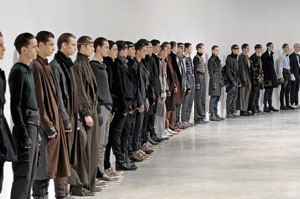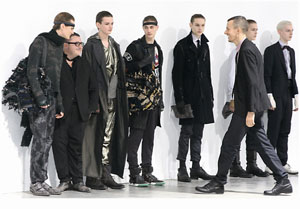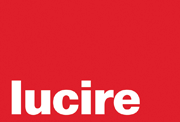|


LANVIN IS ONE OF THE MANY NAME BRANDS
that create the world of haute couture.
Since it was founded in 1890 by Jeanne Lanvin, the meaning of luxury,
elegance and chic was redefined. Lucas Ossendrijver has been Lanvinís
designer in menís prÍt-ŗ-porter since 2006, working alongside Alber
Elbaz, the brandís artistic director. Ossendrijver sat with us during
Paris Fashion Week and gave us a first-class ticket to a journey
through Lanvin Hommeís new seasonís collection.
Lucire: Being brought up in Amsterdam and living
in Paris for ten years, what differences evolve between the two
places?
Lucas Ossendrijver: I think … for me when I arrived in Paris
the big difference was that Paris was quite closed. It takes a lot
of time for you to get to know people, it takes a lot of time for
you to get into Paris actually, and you have to learn to appreciate
it … It is very different, you feel the tradition, you see it in
the architecture, because everything is old, itís almost like a
museum and the difference with Amsterdam is that it is more easy
access, people are open, you can get anywhere really quickly, but
Paris you feel tradition and once you are in, youíre in … People
are very faithful and very reliable.
How fast were you able to get Ďiní?
It took me about three or four years; itís really about working
with people and getting to know people that you learn to appreciate
it.
Can you describe how it was working at Kenzo and Dior Homme in the beginning of your career?
Ah … The companies I worked for are almost like opposites, they
are very different but they sort of complement each other. At Kenzo,
it was my first real job; I learned about collection plans, about
fabrics, about manufacturing, all of the commercial aspects actually.
It was a very good school. At Dior, which was the first time I worked
in a luxury house, a couture house, well you canít get anymore couture
than Dior, so I learned a lot, to go from the extreme to the extremely
precise, to be exigant, as you say in French. You know, to
really go for what you believe in. It was a very good school as
well.
How was it to work at Kenzo and Dior Homme compared to working at Lanvin now?
Very different organizations, a bigger company. You know, we at
Lanvin, we are a smaller company. Itís very family-like, so the
hierarchy is much less, people are very approachable, and you can
go directly to see the manager … the contacts are very different
… It means you have more freedom, actually; and at Lanvin we have
the freedom to dream and the freedom to create and to experiment
without too many people involved and that I think, is very important.
You have been working at Lanvin since 2006, could you tell us what changed since and what you would do to make things better?
I think that what has changed since when I started … I started
really from zero and it was all an experiment and we didnít really
know how things were going to go … there was no marketing strategy,
but we just did just the things we believed in and gradually and
slowly things grew and now we are getting bigger and bigger. So
I just hope to be able to continue this way.
How do you see fashion now as a global perspective in your personal point-of-view?
I think it is becoming more fast and fast and sometimes it is really
scary, because people talk about in and out and the minute your
hot and the next minute youíre not anymore and it always scares
me. I try not to think about it too much, I just try to follow my
intuition and do what I believe in and do what I stand for and I
hope that people understand ; but I donít really try to reflect
on what is hot and what is not, you know I think it is more … I
believe in longevity and things that continue for me. A collection
is more about an evolution and revolution. Itís really about bringing
things slowly forward, without big change.
Could you define what you think fashion is?
Fashion for me, is the freedom to be, fashion to me is also fun
… fashion gives freedom.
What goes through your mind while youíre putting a seasonís
collection together?
Lots of stress [laughs] … My mind goes in all directions,
there are so many problems, thousands of decisions to make, and
things can be one way and next they could be in another way, so
you constantly have decisions to make and decide for yourself whether
it is right or wrong. So your mind is almost boiling over… and you
have to be true to yourself and listen to your intuition, think
what is good, decide for yourself, and thatís what you have to do.
You mentioned that you are already in the process of thinking
about next seasonís collection.
Yes, itís in the process, itís an ongoing process. So you already
start thinking about next season. Things that were right, things
that you want to do better than last season; so itís a work in progress,
it never stops.
Could you describe to us the new seasonís collection?
There is something a little bit more rough, because I think also
you want to reflect a tile you live in and I think for men, times
are a little bit difficult. The whole theme in the collection …
you know, I never work with a thematic collection, in a sense of
this season we do pop culture and next season we do Disney World.
For me, I think there is something protective about the clothes, clothes that you can feel good in, clothes that give you assurance, because when you feel good about yourself, you look good, I think … As I said, there are a lot of coats, and a coat for me, is really about protection, itís about a cocoon, but again itís about different proportions, different shapes. We donít want to dictate fashion; we want to offer different possibilities … Itís really about possibilities.
As I was looking at this seasonís collection, I noticed so much
detail. How do you go along with being able to put so much detail
into one piece of work without making it look over complicated and
making it look so simple?
Actually, that is a little bit my aim. I think as a designer, in
the end, the process is not so important. All the trouble that I
might have in making the clothes right and getting the pattern right
and finding new constructions, in the end you want the clothes to
disappear and what you want to see is the person wearing them. For
me clothes are there to underline a personality, itís not about
the clothes in the end, itís about the wearer, so all the trouble
I might have and all the difficulty I put into the clothes, in the
end they should disappear. Thatís my job.
What do you think about the younger generation in terms of fashion?
What I see about the younger generation is that they are very quick about adapting to themselves, adapting their looks. I think itís really encouraging and really fun to see people experimenting with clothes; trying out new things and not being afraid. For me, there is nothing worse than people putting on a suit because they think they have to go to the office. I like it when people bring in their personality and try to express themselves by clothes; I think the fun element is very important.
How do you find fashion in Paris compared to the other parts
of the world?
I think itís very creative and I think there is lots of freedom
involved and creativity is something thatís actually appreciated
here.
What goal do you hope to achieve in the near future?
Just to be able to continue, I think itís already enough.
Do you think the idea of fashion has gotten better or worse
over the years?
Itís become faster and faster. You know, fast fashion is a little
bit scary, I think because you have to give so many ideas and you
have to go so fast, itís a little bit scary, but itís the way it
is, it is not something I can change.
Is there a particular message you would like to convey to us?
If there is one thing to say, I hope that you enjoy it and I hope
that you have fun with it and try to play with it.
Rola Saab is Paris correspondent for Lucire.
|

